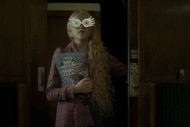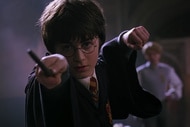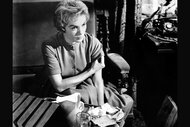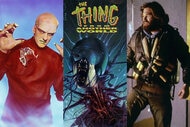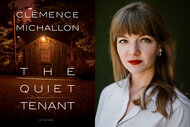Create a free profile to get unlimited access to exclusive videos, sweepstakes, and more!
'Composite Creatures' author Caroline Hardaker built a bleak future drowning in plastic for her debut novel

It is difficult to describe the book Composite Creatures without ruining it. Written by Caroline Hardaker, it's one of those books where the less you know going into it, the better your experience will be. It has elements of science fiction and horror, and it tells an intimate and all-too-real story that has you firmly in its haunted grip long before you even realize it.
The book focuses on Norah, a woman living in a future where nature has become toxic. Plastic has more or less taken over the Earth, a disease called the "greying" strikes humans constantly, and a shady organization called "Easton Grove" has inserted itself into the health care system and is making certain promises about longevity. To prove worthy of their help, Norah has to successfully pair with a man named Art, an American writer whose ideal series of dates is going to see Life of Pi four times. Norah, an unreliable narrator who herself questions the very nature of memory, provides a headspace that is uncomfortable, unsettling, and absolutely spellbinding.
SYFY WIRE caught up with Hardaker to talk about her debut novel, the future depicted within it, and how it all came to be.
Where did the story for this book come from, and how did it evolve?
I was asked to write several poems for a magazine based in Edinburgh, in Scotland, called Shoreline of Infinity. It's a science fiction magazine, and I was trying to rattle off seven or eight poems very quickly. And I tend to like science fiction that's based in the real world. So I was in my living room and I was just scanning the room for any inspiration that I could find. And I wrote one poem about my plants, which ended up being a world where you're responsible for the plant life. So you're carbon neutral. I wrote another poem about an alternative version of tax because there was a tax bill, and then my cat walked in. She was a big cat and she's really weird and she's quite human-esque.
I ended up writing more... but it wasn't based on her. It was called The Matter Cow, and when I wrote that poem, I thought, "Oh, there's almost a short story in that." So I kept it to one side and never sent it. And then I start to work on it a little bit more and I thought, "Ooh, maybe that could be a novella." And then eventually I just started to bullet point things that could happen in this plot, in the world of that poem. And I ended up thinking, "Oh, this could be a full-length novel."
The world-building in this book is immersive and it comes in bit by bit. Was that always the intention, or was there ever a version of this where you had something like a prologue?
It was always intentional. I'm a big fan of the kind of drip, drip approach, and little seeded clues through things. You've got to be careful because it's quite tricky when it's first-person because you're seeing everything through that person's perspective and you're only experiencing the bits of the world that they see or interact with. So in terms of this novel, I could only really see it in world-building aspects that Norah comes across in her everyday life. It would have seemed quite artificial to just do big exposition dumps at times.
Plus, I quite like the idea of it being almost exactly the same as this world, just with a little bit of a dark twist every so often that you read and then you think, "Oh, ooh, what is that? What does that mean?" I wanted this to be quite subtle and I wanted it to be subtle in a way that made people feel a little bit disturbed.
Was there ever a moment in the writing of the story that a character did or said something that you weren't expecting?
Yeah. Generally, when I outline, I outline the story from start to finish, but I don't necessarily stick to it. And in the case of Composite Creatures, the ending that happens in the novel is completely different to the novel that I planned. And I guess somebody like Art, he didn't surprise me so much because I thought, though he has a big role to play in the novel, he's also kind of a device to be an opposite to Norah.
It was Norah that could tend to just surprise me with the things that she did and just how insular she became as the story continued and how she reacted to Art as well. She's trying to kind of convince herself that he's worthy and that she does love him and have affection for him. But does she really? Why is she claiming this? What does it matter? So I think her self delusion to a degree kept surprising me, and the plot did as well by the end, since I completely changed the last third and made it in my head a lot more realistic because I thought, I've tried to base this on a legitimate future that could happen.
Would you say that the future presented here is a real possibility, then?
When I first started the novel… I did then, and I do even more so now. Things like microplastics, contaminating… in a weird way, it was quite prophetic. I didn't envisage when the book came out that things would be quite as near to that future as in the novel. It may not end up in a lilac sky or dying grass or the soles of your shoes might not burn as you walk along the soil. But in theory, all of those things are happening. There is plastic everywhere, and we don't know the full consequences of that.
We have to ask about a detail toward the beginning, which is that Art is a guy who goes to see Life of Pi four times. Is that from real life, or did you make that up?
I made that up. I've never been out with anyone who did that. The reason for that, because it was a specific reason for it, it's ultimately a film where it's about a guy, he tells a story and you don't know how much of it is true. And that's kind of a mirror to what Norah is doing. So we're listening to her story from years down the line, but we can never really be sure how much of it she's twisting to make her come out more of a victim or saluting herself. So I thought Life of Pi without naming the film… it was a bit like a clue, but yeah, no, I've never been out with anyone that went to see anything four times, I don't think.
I however have been to see things four times, I went to see the last The Lord of the Rings film four times. But that's fine.
Five times for me.
That's allowed. That's fine.
Is there any one big thing that you're hoping readers will take away from the book?
I guess one of the big takeaways would be that I want people to imagine themselves in that situation and what they would do, and whether the sacrifices made to have a long life are worthwhile, whether having a long life is a more worthy, worthwhile life than just having a short but meaningful and authentic one. But I also wanted people to think about their relationship to the environment. I mean, that was one of the first things that I wanted to do. And how responsible we are for what's happening in the world, and the little things that we can do to make it different.
I want people to think about the nature of their relationships as well because Norah and Art's relationship is such a big thing that carries the novel through. And it is, by nature, not quite what it seems... I don't want it to be a book that people finish and just instantly forget. Because there's so many of those, I've always wanted to be able to, whether it was in a film or a book, make people think afterward, and write something that would stay with them and change their view on something. Even just for a short period of time. I hope the book does that.
Composite Creatures will be available for purchase on April 13.



